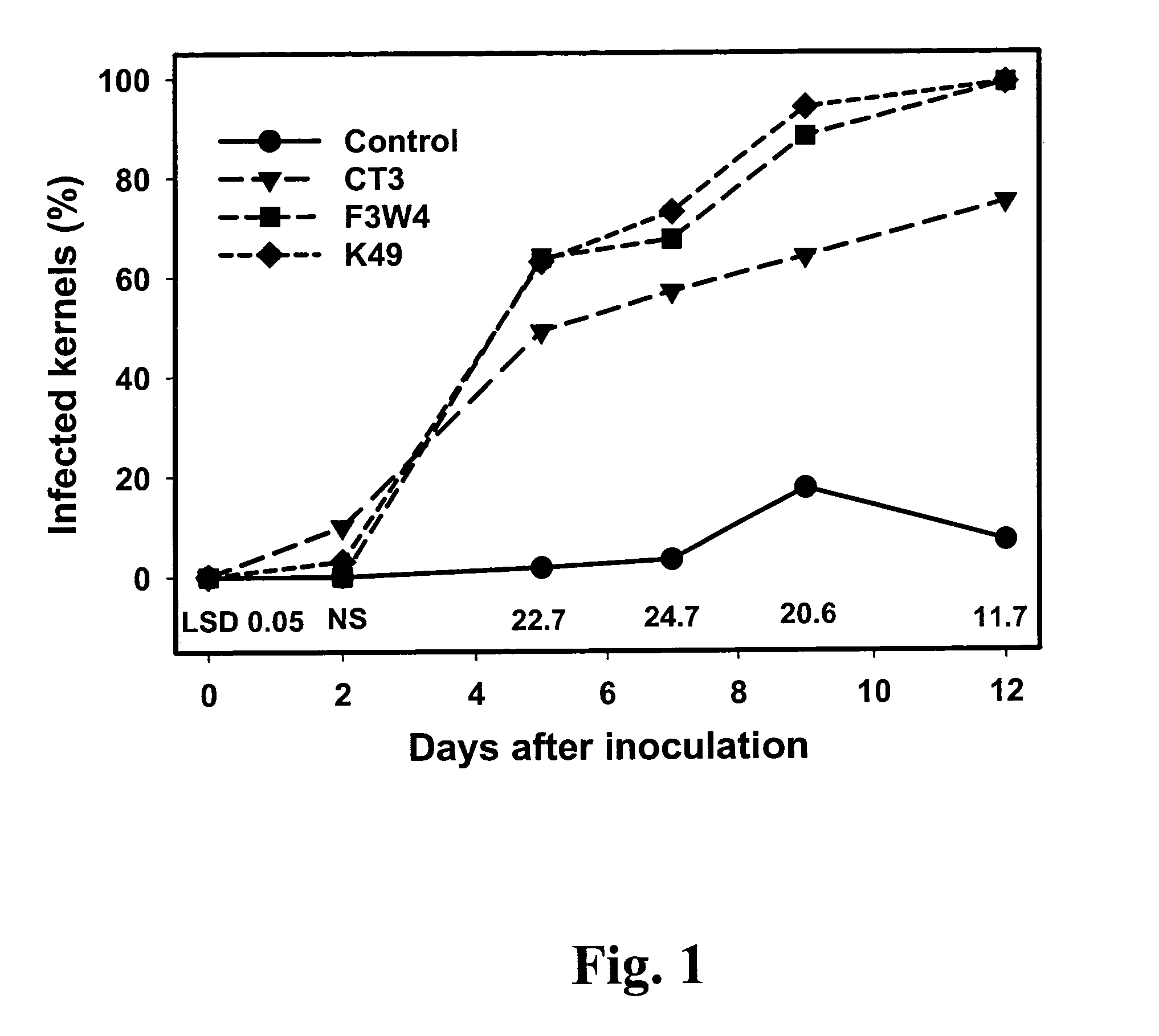Non-aflatoxigenic Aspergillus flavus isolates
- Summary
- Abstract
- Description
- Claims
- Application Information
AI Technical Summary
Benefits of technology
Problems solved by technology
Method used
Image
Examples
example 1
Aspergillus flavus Strains and Characterization Studies
[0026]Aspergillus flavus strains used in this study were isolated as described by Abbas et al. (2004, supra). These strains originated from single spores, and were maintained on Czapak agar slants and stored on silica gel (Horn, B. W., 2003, supra; Windels et al. 1988. Phytopath. 78: 107-109). Non-toxigenic A. flavus strain K49 (NRRL 30797) was isolated from corn grain from Sunflower County, Mississippi in 2001 (Abbas et al. 2005b. Canad. J. Bot., in press). Non-aflatoxigenic A. flavus strain CT3 (NRRL 30798) was isolated in 2000 from Dundee silt loam soil, Washington County, Mississippi, in a field that had been continuously cropped in cotton for over ten years. The toxigenic A. flavus strain F3W4 (NRRL 30796) was isolated from Dundee silt loam soil in Sunflower County, Mississippi, in 2001 (corn / cotton rotation). These strains were selected based on their growth characteristics, sclerotia production and toxin profiles (Table 1...
example 2
Field Study: Inoculum Preparation
[0031]Wheat was used as the inoculant carrier. Wheat seed was soaked in water overnight, drained, placed in autoclavable bags (1 kg / bag with 200 ml water), and autoclaved for 55 min at 121° C. Starter cultures of A. flavus were grown on PDA in 9-cm Petri dishes at 30° C. for 5 d under continuous darkness. The autoclaved wheat was inoculated with the appropriate fungal culture (one 3 cm2 portion of a 5 d PDA plate per bag) and incubated at 35° C. After 24 h growth, the inoculated wheat was manually shaken and incubated for another 24 h and further homogenized by manual shaking. Colonization by the inoculant strain was confirmed by determining aflatoxin concentration in inoculants.
example 3
Field Study: Experimental design
[0032]Corn was planted 23 Mar. 2001, 6 Apr. 2002, 1 Apr. 2003, and 15 Apr. 2004 in a randomized complete block design with a split plot arrangement of treatments replicated four times. The treatments were application of: 1) non-infected autoclaved wheat seed; 2) A. flavus K49-treated wheat; 3) A. flavus CT3-treated wheat; 4) A. flavus F3W4-treated wheat; 5) mixture of A. flavus K49- and F3W4-treated wheat; and 6) mixture of A. flavus CT3- and F3W4-treated wheat. The six inoculation treatments were applied to the same experimental units over the four years of the study. Inoculations were made immediately after cultivation at growth stage V6 (Ritchie et al., 1997. Special Report No. 48, Iowa State University of Science and Technology, Cooperative Extension Service, Ames, Iowa), by scattering the treated wheat seed by hand in the middle furrows at rate of 20 kg / ha for each strain.
[0033]Individual plots consisted of eight rows that were 9.1 m long and spa...
PUM
 Login to View More
Login to View More Abstract
Description
Claims
Application Information
 Login to View More
Login to View More - R&D
- Intellectual Property
- Life Sciences
- Materials
- Tech Scout
- Unparalleled Data Quality
- Higher Quality Content
- 60% Fewer Hallucinations
Browse by: Latest US Patents, China's latest patents, Technical Efficacy Thesaurus, Application Domain, Technology Topic, Popular Technical Reports.
© 2025 PatSnap. All rights reserved.Legal|Privacy policy|Modern Slavery Act Transparency Statement|Sitemap|About US| Contact US: help@patsnap.com

